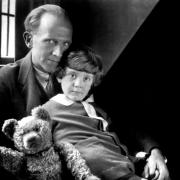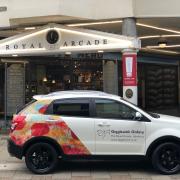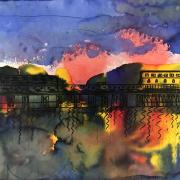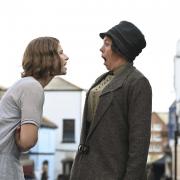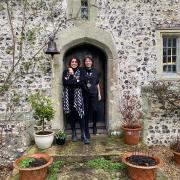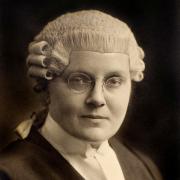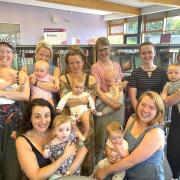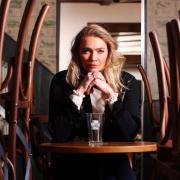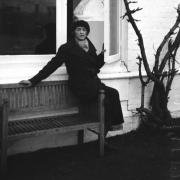Hailsham resident, 92-year-old Brenda Kearley, is a big fan of Call the Midwife as it brings back fond memories of her own career as a midwife in post-war Britain. She trained in midwifery after nursing Blitz casualties during the war. Here is her story as told to her daughter-in-law, Susie Kearley
My midwifery training took place at the GLI (General Lying In) Hospital in London in 1946. I worked 12 hour shifts with a long lunch break, and earned £5 a month plus food and basic accommodation.
The labour ward contained two beds, separated only by a thin partition. There was little privacy when giving birth in hospital in the late 1940s. Women were having babies simultaneously on either side of the partition. Mothers were offered pain relief, gas and air. In those days dads were not allowed to attend the deliveries and visiting hours were very restricted.
I monitored new mothers after they had given birth, to ensure they stayed fit and healthy. We encouraged breastfeeding for the first two or three days, bringing the babies to their mothers at regular feeding times.
Inevitably babies cried and it could get very noisy. Sometimes we mistook stray cats meowing outside the windows for babies crying, and I often went to check that a baby hadn’t been left out there.
Babies didn’t always feed well when we took them to mum. I think today’s policy of leaving babies with their mothers, to feed on demand, is much better.
After birth, the babies were wrapped in a towel, shown to mum and placed on their side in the cot. Medical thinking at the time dictated that you should always lay a baby on its side and switch sides every four hours after feeding, because if you didn’t, a baby’s head would develop unevenly. Laying a baby on its back was forbidden because, at the time, they said it might choke if it was sick. Of course that’s all changed now.
We had some interesting experiences on the ward, including one case of unexpected twins – there were no ultrasounds in those days. On another occasion we had a lady give birth to triplets. These were expected and their mother received a congratulatory visit from Queen Mary, wife of King George V.
I passed my exams and went to work at Epsom hospital in Surrey for the second part of my training. The nurses’ accommodation was delightful! We lived in a plush modern building, which was a welcome change from the basic nurses’ accommodation at GLI.
Soon after we arrived at Epsom hospital, we decided to go to the racing. We didn’t know our way around, so we waited an hour and a half for a bus, only to find out that the racecourse was a 10 minute walk from the hospital. We saw the royal family arrive, watched the racing, and climbed on a fence for a better view, but the fence collapsed.
There was a 10:30pm curfew in the nurses’ quarters and one night, when I’d been out until 1am babysitting, I had to climb back inside through a window, using the fire escape ladder. It wasn’t an incident I ever wanted to repeat, but fortunately I wasn’t caught.
Back on the ward, things were very different to the way they are today. We had none of today’s modern equipment. I remember there was one baby so tiny and quiet that the midwife thought it was dead and put it in the sink – then it started crying.
Sadly, I lost a baby who died from jaundice because it was born Rhesus negative. Today, they have ways of treating the symptoms and preventing these deaths.
After two months in the hospital we were dispatched in pairs to work on the district under the supervision of the local midwife. The mothers were more relaxed in the home environment, and the babies were more contented and quieter.
The houses were inspected for cleanliness before we left. Once they’d been approved, we went off with our delivery packs, just like they do on Call the Midwife. I particularly remember one house because it was disgusting and I don’t know how it passed the inspection. When I arrived, I was horrified at the prospect of delivering a baby there. I tried to clean up, but my efforts were in vain – I was just sending more dust into the air and making things worse! In the end, I just laid clean sheets down and delivered the baby. The birth went smoothly. I was on my own on that one. My training required that I delivered at least two babies at home on my own.
I remember being called out at 10pm to deliver a baby which didn’t arrive until 2 o’clock in the morning. This was quite normal and I’d stay with the patient overnight until they’d had the baby and I was sure that both mother and child were well enough to be left alone. I had to show the mother how to bathe the baby and we used to advise the mother to drink a pint of milk a day because it was thought to improve the quality of the breast milk and helped to replace the calcium lost from breast-feeding.
All new mums were instructed to stay in bed for a week – they usually did as they were told. There had to be someone available to help during this period, and the new mother’s mum was usually in attendance.
On completion of six months at Epsom, I passed my final exams and my name was added to the Royal College of Midwives register. I briefly returned to the GLI as a staff midwife and that’s where I met my late husband, Charles.
The television series is very true to life, but obviously my experience is rather different to the girls in the convent and I didn’t work in the East End. After I got married, I worked with a doctor for a while, attending antenatal classes and infant welfare classes, giving up nursing altogether when I became pregnant in 1951.
READ ON
• Helen Simonson and her new book ‘The Summer Before the War’ - In her first novel, Major Pettigrew’s Last Stand, Helen Simonson created characters and a milieu that captivated her readers. Her new book is a domestic epic that charts the path to war from the perspective of an extended Rye family. She spoke to Jenny Mark-Bell
• Sussex celebrities and personalities share what they love most about the county - Some of Sussex’s best known personalities have revealed in the magazine what they most love about the county. Here, we compile their stories, favourite restaurants, pubs, shops, views and places to visit




